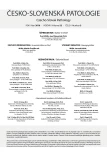-
Články
Top novinky
Reklama- Vzdělávání
- Časopisy
Top články
Nové číslo
- Témata
Top novinky
Reklama- Kongresy
- Videa
- Podcasty
Nové podcasty
Reklama- Kariéra
Doporučené pozice
Reklama- Praxe
Top novinky
ReklamaMolecular genetics and determination of time since death – short communication
Authors: Markéta Šaňková 1,2; Michaela Račanská 3
Authors place of work: Ústav soudního lékařství Lékařské fakulty Masarykovy univerzity a Fakultní nemocnice u sv. Anny, Brno 1; Laboratoř forenzní genetiky, spol. s r. o., Brno 2; Anatomický ústav Lékařské fakulty Masarykovy univerzity, Brno 3
Published in the journal: Soud Lék., 61, 2016, No. 3, p. 28-29
Category: Krátké sdělení
Summary
Estimation of time since death, i.e. the post-mortem interval (PMI), is one of the most problematic issues in forensic practice. Accurate determination of the PMI still remains very complicated task even for an experienced forensic pathologist.
Physical changes including algor, livor and rigor mortis can be observed already during the first hours after death of an individual. Unfortunately, the estimation of PMI on the basis of these changes is often burdened with a certain degree of inaccuracy, which is caused by the temperature of surrounding environment, constitution of the body, cause of the death, location of the body, drug abuse etc.
Accurate PMI estimation requires assessment of such parameters, which change constantly from the moment of death, but independently on ambient factors. According to current research in the field of molecular biology, it appears that a post-mortem degradation of nucleic acids (both DNA and RNA) will correspond to this definition.Keywords:
post-mortem interval (PMI) – taphonomy – molecular genetics – DNA – RNA – nail – tooth
Zdroje
1. Hansen AJ, et al. Crosslinks rather than strand breaks determine access to ancient DNA sequences from frozen sediments. Genetics 2006; 173(2): 1175-1179.
2. Odriozola A, et al. MiRNA analysis in vitreous humor to determine the time of death: a proof-of-concept pilot study. Int J Legal Med 2013; 127 : 573-578.
3. Higgins D, et al. Differential nuclear and mitochondrial DNA preservation in post-mortem teeth with implications for forensic and ancient DNA studies. PLoS ONE 2015; 10(5): 1-17.
Štítky
Patologie Soudní lékařství Toxikologie
Článek vyšel v časopiseSoudní lékařství

2016 Číslo 3-
Všechny články tohoto čísla
- Molekulární genetika a stanovení doby úmrtí
- Životné jubileum prvej dámy slovenského súdneho lekárstva
- Úmrtia v súvislosti s alkoholom – retrospektívna analýza z regiónu severného Slovenska
- Prof. MUDr. Josef Korbička, CSc. – smutná zpráva
- Intrakardiálne pomnoženie plesní rodu Mucor v takmer totálne uhorenom torze tela muža po 10 dňoch od jeho zmiznutia
- Pracovní den soudního lékařství a toxikologie
- IALM Intersocietal Symposium - P5 Medicine & Justice
- Soudní lékařství
- Archiv čísel
- Aktuální číslo
- Informace o časopisu
Nejčtenější v tomto čísle- Prof. MUDr. Josef Korbička, CSc. – smutná zpráva
- Molekulární genetika a stanovení doby úmrtí
- Intrakardiálne pomnoženie plesní rodu Mucor v takmer totálne uhorenom torze tela muža po 10 dňoch od jeho zmiznutia
- Úmrtia v súvislosti s alkoholom – retrospektívna analýza z regiónu severného Slovenska
Kurzy
Zvyšte si kvalifikaci online z pohodlí domova
Autoři: prof. MUDr. Vladimír Palička, CSc., Dr.h.c., doc. MUDr. Václav Vyskočil, Ph.D., MUDr. Petr Kasalický, CSc., MUDr. Jan Rosa, Ing. Pavel Havlík, Ing. Jan Adam, Hana Hejnová, DiS., Jana Křenková
Autoři: MUDr. Irena Krčmová, CSc.
Autoři: MDDr. Eleonóra Ivančová, PhD., MHA
Autoři: prof. MUDr. Eva Kubala Havrdová, DrSc.
Všechny kurzyPřihlášení#ADS_BOTTOM_SCRIPTS#Zapomenuté hesloZadejte e-mailovou adresu, se kterou jste vytvářel(a) účet, budou Vám na ni zaslány informace k nastavení nového hesla.
- Vzdělávání



